
Excellence: We enthusiastically deliver quality services to our customers while consistently seeking to improve those services through creativity and innovation.
Part of the Values at Work Series
Excellence in Action: UT's Building Operations Team – The Central Nervous System of Campus Comfort
Picture a lively university campus, where every building hums with activity, from cutting-edge research labs to serene libraries. Energy flows throughout the rooms and hallways, much like neurons transmitting signals through the central nervous system. Behind the scenes, ensuring everything runs smoothly, is one of the unsung heroes of the campus: the Building Operations team, coordinating and maintaining the vital functions that keep the campus alive and thriving.
“Our team serves as the operators and maintainers of the campus’s central nervous system. We’re very much a communications hub for facilities. We know when a building’s hot, humid, over-pressured, or otherwise, and we can respond quickly to activate our campus resources,” said Assistant Director Brian D. Stokes, who leads the Building Operations team.
This dedicated group, a vital part of the Facilities Operations and Maintenance division, works tirelessly to support the University's mission through three main areas: Facilities Monitoring, Building Automation Systems (BAS) Analysis, and the Building Optimization Team (BOT).
Facilities Monitoring
Facilities Monitoring is the vigilant guardian of the campus. From a centralized Operations Center (referred to as the Facilities Control and Monitoring System or “FCMS”), this team provides 24/7 monitoring of Building Automation Systems (BAS) alarms. They control and oversee mechanical systems to maintain optimal temperature and energy management. This is crucial for sensitive environments such as museums, performance halls, computer rooms, libraries, and laboratories. By managing building systems operations, they conserve resources, reduce environmental impact, and cut utility costs, not to mention maintaining suitable conditions for our students and faculty. Their quick response to system issues minimizes downtime and disruptions, ensuring a seamless experience for everyone on campus.

Take it from Derek DeAtley, a BAS operator who is part of the FCMS team.
“We monitor five different building systems, such as heating, ventilation, and air conditioning (HVAC), for 130 buildings on or near Main Campus and 20 at the J.J. Pickle Research Campus. That includes watching out for flood alarms, issues with pressure, temperature, or hot water pumps, for example. It’s our job to keep an eye on things, make sure there’s nothing out of whack or too dangerous. If there’s an alarm, and that’s a high-priority thing, we’ll write it up for the zone to take a look, see what the problem is.”
DeAtley provided a vivid example of monitoring research.
“Over at Patterson, they have a bunch of greenhouses on the roof with butterflies. We monitor the temperature there, so when it gets really cold or too hot, we alert the researchers so they can adjust the temperature to keep the butterflies safe.”
One of their standout features is the Critical Alarm Response Systems (CARS). This high-priority alert system is designed to protect the invaluable research conducted at the University. When a CARS alarm is triggered, operators immediately spring into action, evaluate the issue promptly, and alert equipment owners to ensure the proper handling of critical research materials to prevent potential losses.
Additionally, the team operates an After-Hours Maintenance Call Response and Dispatch service. Given the size and complexity of the University, facilities-related issues can arise at any time. The after-hours call center, reachable at 512-471-2020, dispatches specialized first responders to address urgent maintenance needs, preventing extensive property damage and minimizing building downtime.
As DeAtley said, “We’re like a safety net” for the campus.
Building Automation Systems Analysts

Next, we have the Building Automation Systems (BAS) analyst team. These experts perform high-level troubleshooting and diagnostics on the BAS platforms to ensure the proper functioning of facility systems. They create and edit automation sequences to enhance building performance and reduce energy consumption. They also coordinate with Information Technology Services Networking to resolve communication issues and regularly support the maintenance zones and other campus clients. Additionally, the BAS analysts serve as subject matter experts for BAS-related projects. Their work ensures reliable connectivity to building systems, maintaining visibility for FCMS, the zone shops, and our campus clients.
DeWayne Waldrop and Max Brookover are two of the BAS analysts who bring their extensive experience and knowledge to their work for the University. Serving in this role is no easy task.
"We have a broad knowledge base, which includes aspects of information technology, engineering, and BAS programming” Waldrop said. This combined expertise helps them resolve issues when instrumentation and controls (I&C) technicians in the field reach out to them for support. “We maintain the backbone with the data stream, communicating across the network on a specific level separate from IT, but on the same backbone as UT."

What does a day in the life of a BAS analyst look like? "The technicians rely on us to know everything about what they're looking at," Brookover said. “A typical example of what we do on a daily basis is to take a call from an I&C technician and help them troubleshoot issues with a specific air handler in a specific building out in the field.” Since there are 150 buildings at the University with various systems and programs, the analysts need to know these details to implement the applicable solution.
BAS analysts also team up with another University department, Utilities and Energy Management (UEM), to implement demand-side energy management strategies. "We do a lot of programming for energy savings too," Waldrop said. For example, the UEM energy management team identifies buildings where HVAC systems can safely be set back during unoccupied operating hours — usually overnight, on weekends, and during some University holidays and breaks. BAS analysts adjust low-occupancy and non-environmentally sensitive spaces. There are currently 66 buildings on a weekend and overnight schedule, with an average energy reduction of 17%.
Both Waldrop and Brookover echoed the goal of the Building Operations team. "We basically just keep these buildings running so the customers or students and faculty are walking into a comfortable building."
Building Optimization Team
Finally, the Building Optimization Team (BOT) is the technical powerhouse that fine-tunes existing building equipment and systems. Through a process known as retro-commissioning, they assess building systems to identify and rectify failures and inefficiencies. They collaborate with Zone Maintenance and the Replacement & Renewal Program to make necessary repairs and improvements. By working with energy engineers and BAS analysts, they implement programming and parameter changes to boost building efficiency.

The BOT uses the latest technology to measure various aspects of HVAC systems, ensuring they operate efficiently. They coordinate closely with individual building managers in an effort to minimize disruptions to building occupants.
The BOT also serves as a valuable resource to our Planning, Design and Construction clients, providing testing, adjusting and balancing services for various renovation projects. The BOT can provide these services with improved quality, availability, and cost.
John Duttinger, BOT supervisor, provided his behind-the-scenes perspective.
"Optimizing the performance of buildings on campus is no small feat. It takes a diverse skill set and a wealth of experience across various mechanical and automation systems. Our campus is home to some of the oldest buildings in Austin, which sit right across the street from the newest, most technologically advanced structures being built today. Our team of building controls and commissioning technicians rise to the challenge of this diverse campus infrastructure by collaborating with other departments within Facilities Services. They also receive specialized training in the latest techniques and best practices in building sciences to ensure everything runs smoothly.”
Building Operations: Getting It Done Right

On a daily basis, the Building Operations team embodies the One Great Team (OGT) value Get It Done Right — consistently striving for excellence through an unwavering commitment to competence, informed decision-making, and a focus on high-quality results. They also embody the Facilities Services value of Excellence because they enthusiastically deliver quality services to our customers while consistently seeking to improve those services through creativity and innovation.
As the central nervous system of the University’s infrastructure, the Building Operations team ensures a safe, efficient, and comfortable environment for everyone.
For more information, contact Assistant Director Brian D. Stokes at brian.stokes@austin.utexas.edu or 512-232-8391. Join us in celebrating the incredible work of the Building Operations team, the silent guardians of our campus!
